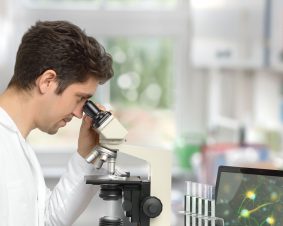 >
Spotlight June 2021: Endotoxin – the reason for false-positive toxicity testing for advanced materials?
>
Spotlight June 2021: Endotoxin – the reason for false-positive toxicity testing for advanced materials?
Advanced materials, but also nanomaterials are closely examined to determine whether they trigger biological effects that could be harmful to humans and the environment before they are used in products. This also includes such materials as titanium dioxide, which has been used in a wide variety of products for more than 50 years. A particularly important biological reaction to “foreign substances” in humans and animals is the inflammatory response, as this represents a defence mechanism in which the body defends itself with various reactions: redness, heating (fever), swelling and pain are the first signs and possibly lead to a functional impairment of the organ that is affected. As a result, this reaction is also particularly frequently studied in toxicology laboratories and almost as frequently misinterpreted.
But what are the reasons for the frequently false-positive results, e. g. with gold particles or the titanium dioxide particles mentioned above? It has long been known that a bacterial cell component is responsible for such false determinations. This is because the so-called “endotoxin” or lipopolysaccharide (LPS) is found everywhere in our environment, even without bacteria, and particularly likes to bind to small particles, such as nanoparticles [1, 2]. This endotoxin then triggers the defence reaction without the material itself having to contribute anything.
In their recent review article, the Italian/Spanish group draws attention to the fact that before measuring an inflammation-inducing effect of materials, it is essential to examine the material to determine whether it contains bacterial contaminants (endotoxin) [Mangini et al., 2021]. And in addition, they indicate that the selection of the appropriate determination method is also important, since the nanoparticles can interact with the test methods, causing additional errors that can lead to false-positive or even false-negative evaluation of the results. However, from a regulatory point of view there is no rule (except for medical applications) that requires the detection or absence of endotoxins when it comes to the toxicological evaluation of advanced materials. Thus, it can be assumed that many of these materials are contaminated with endotoxin and therefore the statements about their inflammatory capacity may be incorrect. The authors therefore present a decision tree that should be applied before any testing of nanomaterials or advanced materials to avoid exactly these mistakes. On the one hand, the question of whether endotoxin is present in the samples must be answered, and on the other hand, it must also be considered whether the appropriate test has been selected that should be used for the material in question.
The DaNa project also evaluates the literature on toxicity according to this criterion, among others, and has included the detection of endotoxin into the catalogue of evaluation points (see also https://nanopartikel.info/en/knowledge/literature-criteria-checklist/).
Original Publication:
Mangini, M et al. (2021). Interaction of nanoparticles with endotoxin Importance in nanosafety testing and exploitation for endotoxin binding. Nanotoxicology, 15(4): 558-576.
Further literature cited
- Bianchi, MG et al. (2017). Lipopolysaccharide Adsorbed to the Bio-Corona of TiO2 Nanoparticles Powerfully Activates Selected Pro-inflammatory Transduction Pathways. Front Immunol, 8 866.
- Li, Y et al. (2017). Bacterial endotoxin (lipopolysaccharide) binds to the surface of gold nanoparticles, interferes with biocorona formation and induces human monocyte inflammatory activation. Nanotoxicology, 11(9-10): 1157-1175.

Weitere Spotlights
Spotlight January 2023: Special issue on Methods and Protocols in Nanotoxicology published
In the first Spotlight of the new year, we present a special issue on methods and protocols in nanotoxicology published in the journal Frontiers in Toxicology. There are still too few harmonized protocols accepted by the scientific community. To improve this situation, project activities are started and special issues of journals like this one are […]
Read moreSpotlight January 2022: Methods, models, mechanisms and metadata
For the new year, we are presenting no “classic” paper here, but would like to point out an editorial: Methods, Models, Mechanisms and Metadata: Introduction to the Nanotoxicology Collection at F1000 Research. This editorial introduces the F1000Research Nanotoxicology Collection, where best practices can be collected in the form of original research reports, including no-effect studies, […]
Read moreSpotlight July 2022: New definition on nanomaterials published
The European Union has published a new definition for nanomaterials as of June 2022. It is recommended that this be used as a basis for future legislation. The new documents can be found on the EC website. In the new “nanodefinition”, the essential components such as the origin or the size range of the particles […]
Read moreSpotlight July 2021: The Path to Digital Material Research – It is never too late to start
Machine Learning, Artificial Intelligence, Big Data…. Have you read these words lately? No, these are not just buzzwords. The digitalisation of science is an evolving topic that is gaining importance with each passing day. That is why this month we would like to introduce you to the article “Digital Transformation in Materials Science: A Paradigm […]
Read more


